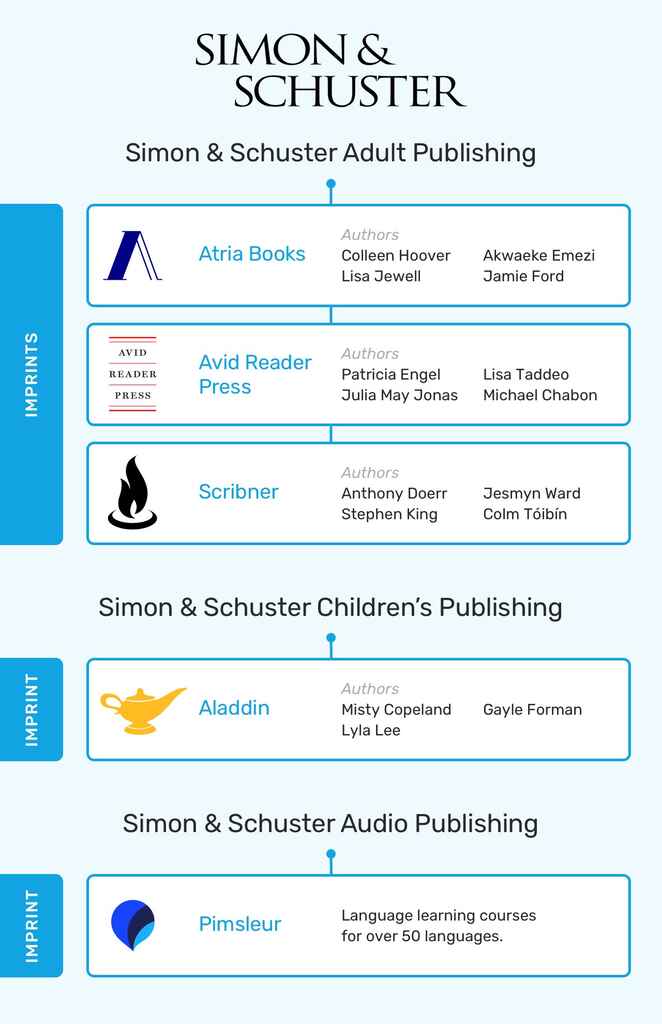Blog • Understanding Publishing
Last updated on Oct 14, 2025
What is an Imprint? A Division of a Larger Publisher
Linnea Gradin
The editor-in-chief of the Reedsy Freelancer blog, Linnea is a writer and marketer with a degree from the University of Cambridge. Her focus is to provide aspiring editors and book designers with the resources to further their careers.
View profile →An imprint is the brand or trade name of a press that is owned by a larger publisher, which often publishes books that target specific niches and reading demographics. For example, Penguin Random House is a massive publishing company with many smaller imprints, like Alfred A. Knopf, Penguin Classics, Everyman’s Library, and Doubleday.
Most imprints are created in one of the following ways:
- A publisher acquires or merges with another publisher, allowing the smaller entity to keep their branding but operate as an imprint of the larger company;
- A publisher creates an imprint from scratch to capitalize on a niche audience that doesn’t fit with their main brand identity; or
- A self-publishing author registers an imprint to create legitimacy, buys ISBNs in bulk, or publish other authors.
If you’re still confused about what imprints are and why they matter, don’t worry — we’ve asked three Reedsy editors with experience working for Big 5 publishers and compiled everything you need to know about imprints in this post.
Imprints often work within a niche or territory
Imprints come in all shapes and sizes, but one of the main features and benefits of imprints is that they often publish a cohesive line of books to fit into a specific niche or segment of the market. You can think of imprints as a kind of branding for books; much like H&M is split into H&M Kids, H&M Home, and H&M Sport, a publishing company may be split into contemporary fiction, children’s books, and classics, for instance. As former Hachette and HarperCollins editor Dominic Wakeford explains, imprints are “essentially branches of the same company in the same building.”
And much like the imprinting of werewolf romance plotlines (looking at you Twilight), it all comes down to creating a perfect match — in this case, the match is between an imprint's brand identity and its core readership. This is something that Reedsy editor Alyssa Matesic, formerly of Penguin Random House and Macmillan, confirms: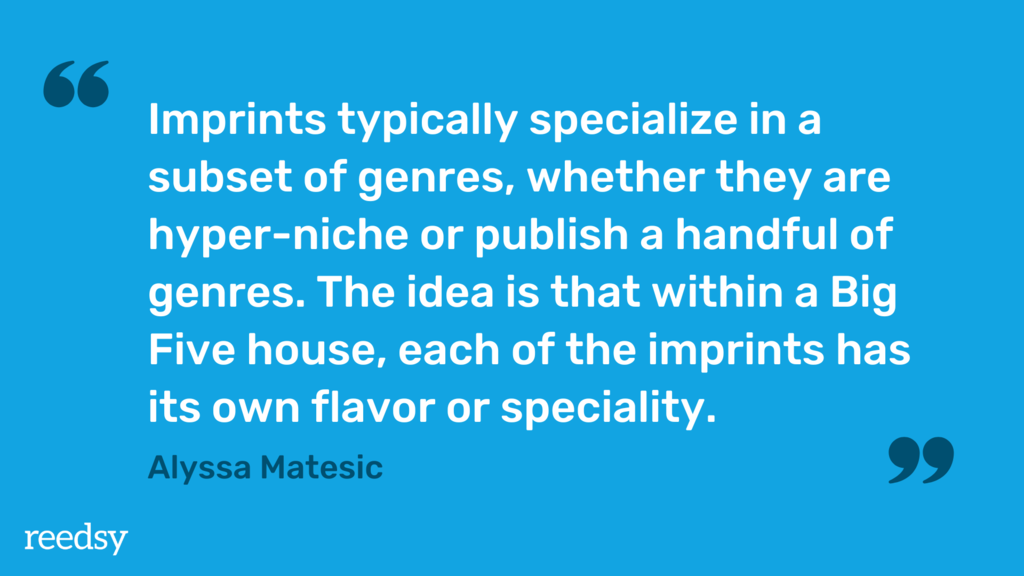
Doing market research to find your niche?
Download Reedsy's Market Research Checklist!
With that said, Aja Pollock — a Reedsy editor who has worked with Penguin Random House, Macmillan, and HarperCollins — notes that some imprints are more niche than others:
“Anything from Tor is going to be sci-fi or fantasy; Howard publishes Christian books; etc., but a lot of imprints have pretty vague mission statements that amount to ‘We publish stuff we think is interesting!’”
This might make imprints seem like a technicality that simply allows the powers-that-be to better manage editorial staff and marketing budgets, but at the same time, a successful imprint with a strong brand identity can give readers a sense of what to expect from titles they publish.
Take some of Penguin Random House’s imprints as an example: Penguin Classics reissues books that have stood the test of time, while Doubleday focuses more on new commercial and literary fiction.
The black spines, classic cover motifs, and extensive introductions in Penguin’s black classics line might attract readers with a ‘serious’ interest in knowledge or culture, while the eye-catching, photogenic covers of Doubleday’s contemporary titles will appeal to bookstagram users or anyone who color-categorizes their bookshelves.
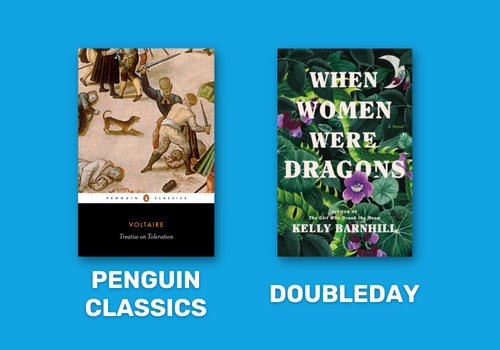
On a practical level, focusing on a particular niche makes it easier for an imprint’s editorial staff to keep their finger on the pulse of their target readers — instead of having to keep an industry-wide view of trends. It also allows for more targeted recruitment, as they can attract editors with an interest and experience in that category or genre.
Let’s examine one of the ‘Big 5’ publishers—Simon & Schuster—and some of its imprints to get a better sense of how that works.
Free course: Inside a Traditional “Big 5” Publisher
Curious about “Big 5” publishers? Take this 10-day online course led by Reedsy editor Dominic Wakeford, previously at HarperCollins and Hatchette.
Example: Simon & Schuster
![The image shows different imprints and their authors at Simon & Schuster]()
Not only does Simon & Schuster publish under the flagship name Simon & Schuster, but the company has multiple imprints organized into groups, according to the broad market segment they’re targeting. There’s:
- Simon & Schuster Adult Publishing
- Simon & Schuster Children’s Publishing
- Simon & Schuster Audio Publishing, and
- Simon & Schuster International (covering Australia, Canada, India, and the UK).
Each of these groups has several well-known imprints — some with their own independent history and a few created by the parent publisher themselves — and together, they contribute to Simon & Schuster’s overall output. As Alyssa Matesic puts it, "Imprints often have their own independent history before the publishing house acquired them, and you'll see vestiges of that in the books they publish today."
Some examples include:
Adult: Scribner
Scribner continues to solidify its long-lasting brand by both holding the rights to modern classics and publishing commercially successful literature with authors such as Stephen King and Anthony Doerr.
Adult: Avid Reader Press
Avid Reader Press was founded by Simon & Schuster in 2018. Their brand identity leans towards upmarket fiction, with titles such as Animals by Lisa Taddeo and Vladimir by Julie May Jones.
Adult: Atria Books
Atria Books’ mission is to be an environment for new ideas and voices within the upmarket fiction and commercial genres, and is home to authors such as Akwaeke Emezi, Fredrik Backman, Colleen Hoover, and Lisa Jewell.
Children’s: Aladdin Books
As one of Simon & Schuster Children's Publishing imprints, Aladdin Books publishes a wide range of children’s books. From chapter books to graphic novels to picture books, they boast award-winning titles and authors such as Black Ballerina by Misty Copeland, and the Mindy Kim series by author Lyla Lee and illustrator Dung Ho.
Audio: Pimsleur
Simon & Schuster also ventured into the audio and educational market when they acquired the popular language learning resource Pimsleur in 1995. Originally distributed in CD-format to bookstores and via mail order, today the product is mainly sold as course packages available online or via a subscription app.
With these and many more imprints, Simon & Schuster manages to reach across the market and provide targeted books for many kinds of readers. With the backing of a powerful parent publisher, both small and large imprints can play in the big league.
Up for a challenge? Head over to our directory of 400+ book publishers, identify some large ones, and use Google to identify their major imprints. You’ll be surprised by how many you’ve already heard of!
Imprints benefit from the resources of their parent company
Now, you might be wondering how resources are distributed amongst imprints and the answer is that it differs from one publishing company to the next. According to Aja Pollock and Dominic Wakeford, however, imprints all tend to have their own resources like editorial and marketing staff, while they share production, design, and sales teams with their stablemates. And while Wakeford notes that some larger, better-established imprints might get a larger slice of the resource pie, one thing that most traditional imprints have in common, regardless of size, is that they all benefit from being connected to a powerful parent company.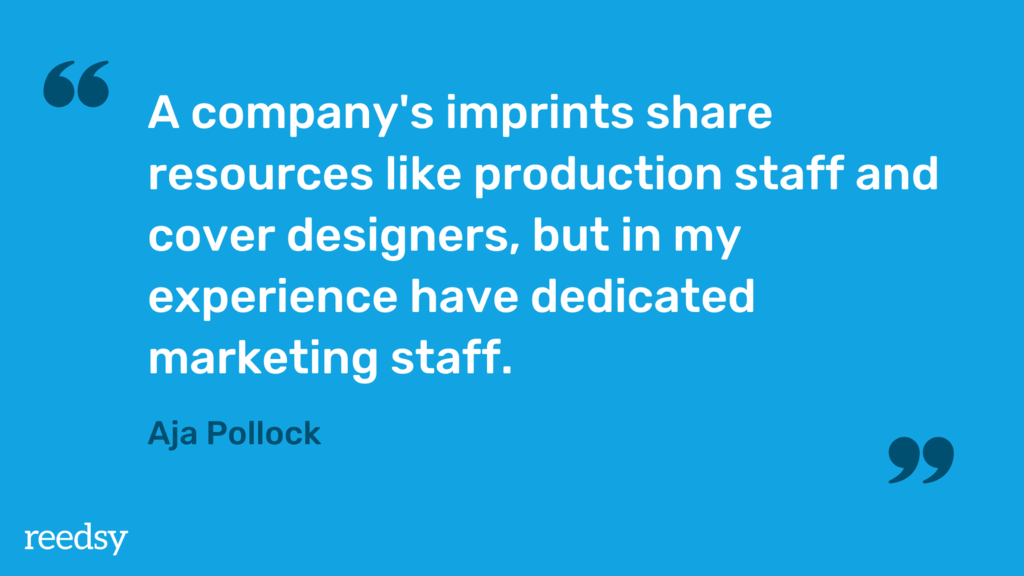
Getting books into stores
Perhaps the biggest advantage of having a large parent company is the ability to get books into stores and in front of readers. For instance, Wakeford explains that imprints don’t have to set up individual meetings with major book retailers to get their books into stores like Barnes & Noble and Waterstones. Instead, the joint sales team of the parent publisher will meet with them on one occasion — typically a full day — to pitch all their titles across all their imprints.
With the ability to offer booksellers discounts on certain titles, access to big-name authors for in-store signing, and other kinds of perks, their expert sales teams can also negotiate books from their different imprints into window displays, email newsletters, facing outwards on shelves, or included in various in-store promotions.
Though it may be a tad harder, indie publishers and authors can also get their books into brick-and-mortar-chains. Check out Carol Cooper’s story to see how she did it.
Getting the book in front of retailers and readers is arguably the whole point: once the general reader is standing in a store with a promising new title in their hands, they don’t care much about the name or size of the imprint that published it.
Free course: Traditional Publishing 101
Want to sell your book to a major publisher? Get the inside scoop on traditional publishing with this 10-day online course.
Readers aren’t usually loyal to imprints
Even though publishers and retailers may pay a lot of attention to the branding of individual imprints, readers don’t usually care about what imprint a book is published under as long as the cover and blurb meet their expectations. In Wakeford’s experience “the outward branding doesn’t mean an awful lot to the average consumer” and is largely used to differentiate between titles and branding amongst publishing professionals.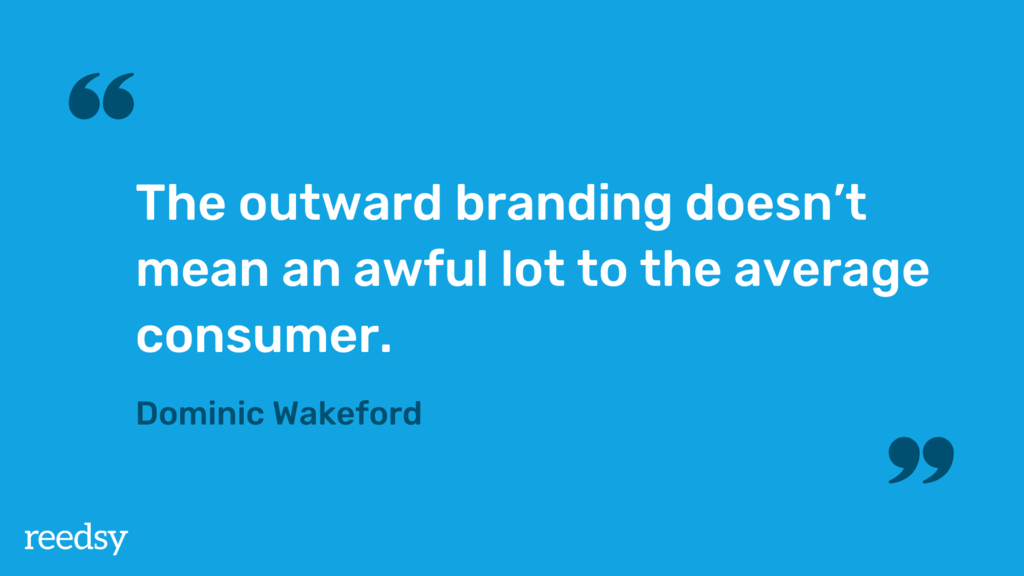 Some avid readers may have favorite publishers which they associate with genres or styles of writing that they enjoy, but that usually doesn’t sway them from getting books from other presses. Think of readers as serial polygamists, switching between different publishers and imprints; if the marketing is on point and targeted towards the right audience, they won’t be fussy about logos and labels. They’re open-minded like that.
Some avid readers may have favorite publishers which they associate with genres or styles of writing that they enjoy, but that usually doesn’t sway them from getting books from other presses. Think of readers as serial polygamists, switching between different publishers and imprints; if the marketing is on point and targeted towards the right audience, they won’t be fussy about logos and labels. They’re open-minded like that.
That said, there are a few exceptions to this rule.
Example: Harlequin
Some publishers are so strongly associated with one category or style of writing that readers sometimes decide whether to pick up a book based solely on the publisher, rather than the author or book cover. One such example is Harlequin — a world-leading romance and women’s fiction publisher.
The press joined HarperCollins as its own division in 2014, and hosts several imprints (or “series” as they call it) of their own — from Harlequin Historical to Harlequin Medical Romance and Love Inspired, covering various romance subgenres. The concept of the Harlequin novel is so well established that it has practically become synonymous with the women’s fiction genre, leaving readers in two camps — those who unreservedly stay away from anything the publisher puts out, and those who actively seek them out.
The concept of the Harlequin novel is so well established that it has practically become synonymous with the women’s fiction genre, leaving readers in two camps — those who unreservedly stay away from anything the publisher puts out, and those who actively seek them out.
If none of the many imprints out there appeal, authors can also choose to go down the self-publishing route — and even set up their own imprints to create an extra layer of legitimacy.
✅
Is self-publishing or traditional publishing right for you?
Takes one minute!
Indie authors can set up imprints (for the extra prestige)
For authors looking to take the indie publishing route, setting up an imprint can be a great way to punch above your weight. Remember how an imprint is essentially just the trade name you publish a book under? That means the imprint name appears as the publisher on copyright pages and retailer book descriptions.
Instead of publishing under their own name, or that of a self-publishing service (such as KDP or CreateSpace) an indie author can easily set up an imprint to add an extra layer of professionalism to their books.
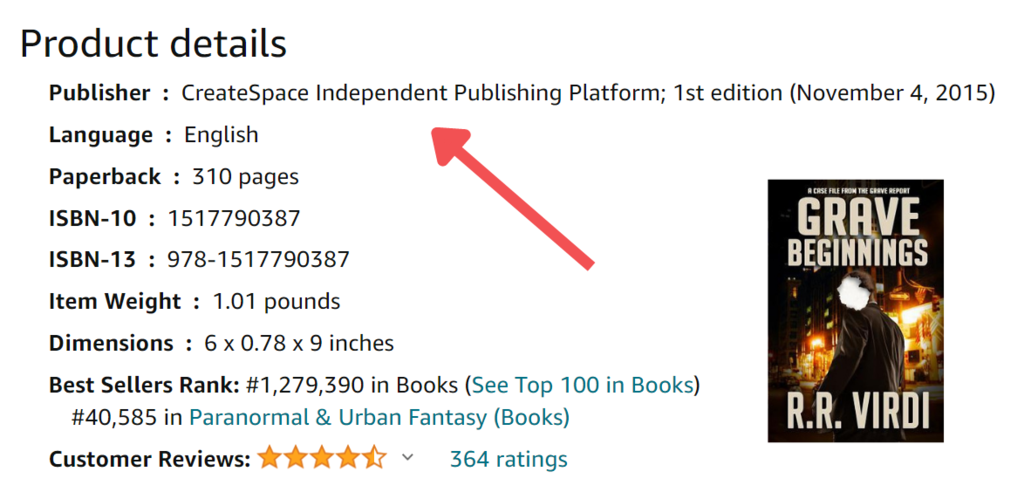
Setting up an imprint of one’s own means that not only can you publish your own work, but you can also offer other authors a book deal — whether that be work by one author’s many pseudonyms or other self-publishing colleagues. More and more author-run imprints like this are cropping up, with imprints such as LMBPN Publishing, WolfPack Publishing and Portal Books seeking to consolidate themselves in their respective niches and build a returning reader base.
Setting up your own imprint
If you want to set up your own imprint, you need to either file a Fictitious Business Name (FBN) or a Doing Business As (DBA) certificate to the relevant authority in your country and/or state, set up your business for taxes, and obtain a business license. Then you can use your imprint name to buy your own ISBNs on sites like Bowker.com or Nielsenisbnstore.com.
Of course, there’s a bit more that goes into starting an imprint, so check out our post on starting your own publishing company for a more comprehensive guide on the topic. Or why not get your feet wet with this introductory video:
